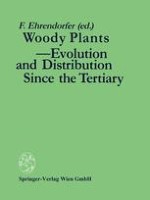1989 | OriginalPaper | Buchkapitel
Paleobotanical evidence on the early radiation of nonmagnoliid dicotyledons
verfasst von : Peter R. Crane
Erschienen in: Woody plants — evolution and distribution since the Tertiary
Verlag: Springer Vienna
Enthalten in: Professional Book Archive
Aktivieren Sie unsere intelligente Suche, um passende Fachinhalte oder Patente zu finden.
Wählen Sie Textabschnitte aus um mit Künstlicher Intelligenz passenden Patente zu finden. powered by
Markieren Sie Textabschnitte, um KI-gestützt weitere passende Inhalte zu finden. powered by
Paleobotanical studies indicate that several isolated and systematically depauperate groups of extant woody dicotyledons originated in the Mid Cretaceous. The Chloranthaceae had probably differentiated into insect-pollinated (Chloranthus and Sarcandra) and wind-pollinated (Ascarina and Hedyosmum) forms by the end of the Albian, and leaves referable to the Trochodendrales are known from the Albian and Cenomanian. In the latest Cretaceous and Early Tertiary, extinct representatives of the Trochodendrales included Nordenskioldia and the Joffrea-Nyssidium complex. The Platanaceae also differentiated before the end of the Albian and initially had insect-pollinated, unisexual flowers with five carpels or stamens. Some of these features persisted in the platanoid lineage until the Early Tertiary, and during the Paleocene and Eocene the Platanaceae included forms with elliptical, palmate and pinnate foliage. The history of the Platanaceae suggests that several features of the reproductive morphology of extant taxa may have arisen in association with a trend toward wind pollination. In the Mid Cretaceous, platanoid foliage partially inter-grades with pinnate Sapindopsis and pedate Debeya-Dewalquea leaves suggesting a close relationship between Platanaceae and Rosidae and Fagaceae respectively. The Chloranthaceae, Trochodendrales, and Platanaceae all occupy a somewhat intermediate position between the Magnoliidae and Hamamelidae and are of considerable interest with respect to their role in the initial radiation of nonmagnoliid (“higher”) dicotyledons.
